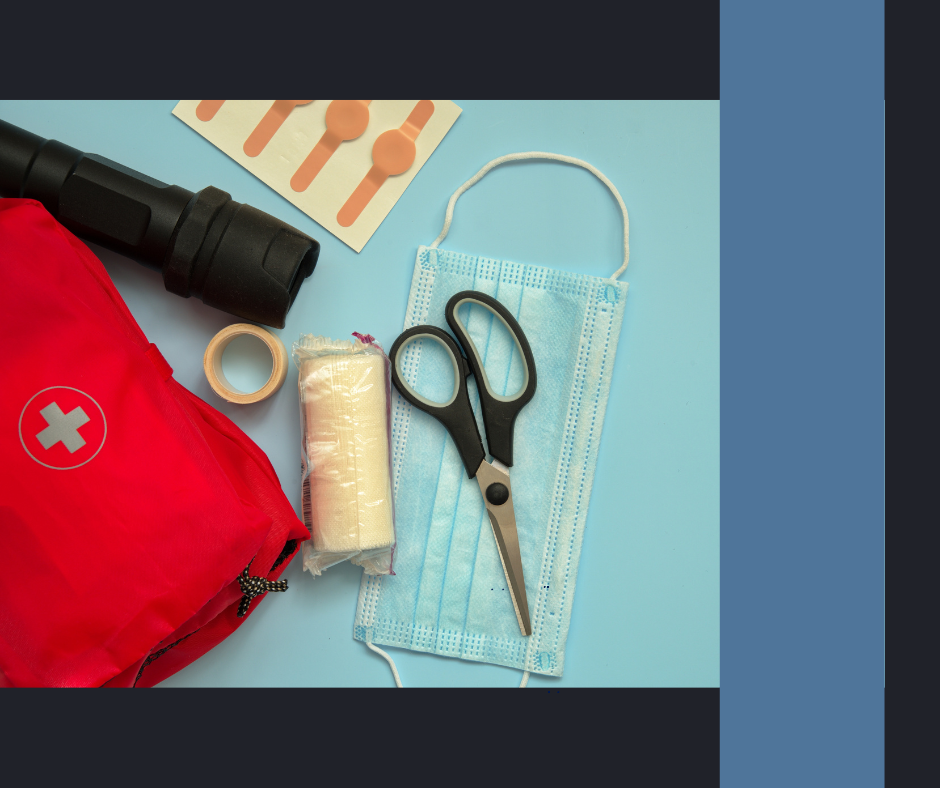
Essential First Aid & Medical Supplies for Emergency Preparedness
Share
In an emergency, access to medical care may be delayed. Whether it’s a natural disaster, power outage, or personal crisis, having the right first aid and medical supplies can make a huge difference. A well-stocked first aid kit is a must-have for every home, car, and emergency bag.
Here’s what you should store to handle minor injuries and medical emergencies.
1. Basic First Aid Supplies
These are the essentials for treating cuts, burns, scrapes, and minor injuries.
✅ Bandages & Dressings:
- Adhesive bandages (various sizes)
- Sterile gauze pads (4x4 and 2x2 inches)
- Medical tape
- Elastic bandages (for sprains and strains)
- Non-stick sterile pads
✅ Cleaning & Disinfecting:
- Antiseptic wipes
- Alcohol prep pads
- Antibiotic ointment (like Neosporin)
✅ Pain Relief & Anti-Inflammatory Medications:
- Acetaminophen (Tylenol)
- Ibuprofen (Advil, Motrin)
- Aspirin (important for heart attack symptoms)
✅ Burn Treatment:
- Burn gel or aloe vera
- Hydrogel dressings
✅ Splinting & Immobilization:
- Finger splints
- SAM splint (flexible, moldable splint)
- Triangle bandages (for slings)
✅ Eye Care:
- Saline solution or sterile eyewash
- Eye drops (lubricating or allergy relief)
✅ Gloves & Protection:
- Nitrile gloves (non-latex)
- Face masks
- CPR mask with one-way valve
✅ Wound Closure Supplies:
- Butterfly bandages
- Steri-strips
- Skin glue (like Dermabond)
2. Medications & Specialty Items
Depending on your needs, you may want to store these extra supplies:
✅ Cold, Allergy & Stomach Relief:
- Antihistamines (Benadryl, Claritin)
- Anti-diarrheal (Imodium)
- Electrolyte packets (for dehydration)
- Antacids (Tums, Pepto-Bismol)
- Cough syrup or lozenges
✅ Prescription Medications:
- A backup supply of any necessary prescriptions (if possible)
- EpiPen (if needed for allergies)
- Inhalers for asthma
- Check out this article to learn about storing medications and where you can get antibiotics and other medications for your emergency supply.
✅ Skin & Rashes:
- Hydrocortisone cream
- Anti-fungal cream
- Calamine lotion (for poison ivy or bug bites)
✅ Dental Care:
- Temporary filling material
- Clove oil (for tooth pain)
- Dental wax
✅ Diabetes Supplies:
- Glucose tablets or gel
- Extra insulin and syringes (if applicable)
- Ketone test strips
3. Emergency & Trauma Supplies
For more serious injuries, these supplies can be life-saving:
✅ Severe Bleeding Control - If you store these please take a class and learn how to use them first:
- Tourniquet (CAT or SOFTT recommended)
- Israeli bandage (pressure dressing)
- Hemostatic gauze (like QuikClot)
✅ Airway & Breathing Support- If you store these please take a class and learn how to use them first:
- Nasal airway kit (NPA)
- Bag-valve mask (for assisted breathing)
✅ Fracture & Dislocation Treatment:
- Instant cold packs
- SAM splint
- Ace bandages
✅ Shock & Hypothermia Prevention:
- Mylar emergency blankets
- Heat packs
4. Tools & Miscellaneous Items
A first aid kit isn’t complete without these essential tools:
✅ Medical Tools:
- Digital thermometer
- Tweezers (for splinters or ticks)
- Trauma shears (for cutting clothing/bandages)
- Safety pins (for securing bandages or slings)
✅ Light & Communication:
- Flashlight or headlamp
- Extra batteries
- Whistle
✅ Documentation & Guides:
- First aid manual
- List of emergency contacts
- Copies of medical records (especially allergies & conditions)
5. Long-Term & Disaster Medical Supplies
If medical care is unavailable for an extended period, consider storing:
✅ Wound Care & Infection Prevention:
- Betadine or iodine solution
- Extra gauze and bandages
✅ Respiratory & Infection Control:
- N95 masks
- Pulse oximeter (measures oxygen levels)
✅ Alternative Medicine & Herbal Remedies: (learn how to use these safely as some can interact negatively with prescription medications)
- Essential oils (lavender, tea tree, etc.)
- Herbal tinctures for immune support
Final Tips for Medical Preparedness
✔ Store items in a waterproof container – Keep your kit dry and easily accessible.
✔ Check expiration dates regularly – Replace medications and supplies as needed.
✔ Take a first aid class – Knowing how to use your supplies is just as important as having them!
✔ Keep a kit in multiple places – One at home, one in your car, and one in your emergency bag.
Bonus: In emergency situations, medical knowledge can be life saving. Most people don't have professional medical backgrounds, so having a hard copy resource of what to do in an emergency situation when medical professionals are not available is vital. This link will take you to our medical book recommendation written by medical doctors on what to do when help is not on the way, found on Amazon.
Being prepared means having the right supplies before an emergency happens. Build your kit and your resources now so you’re Ready & Prepped for whatever comes your way!
No fuss. No fluff. No fear.
Other Articles of Interest:
Storing Medicine for Emergencies: What you Need to Know
Natural Remedies to Include in your Emergency Supplies
Herbs to Grow in Your Garden: For Health and Flavor (Including Medicinal herbs)
